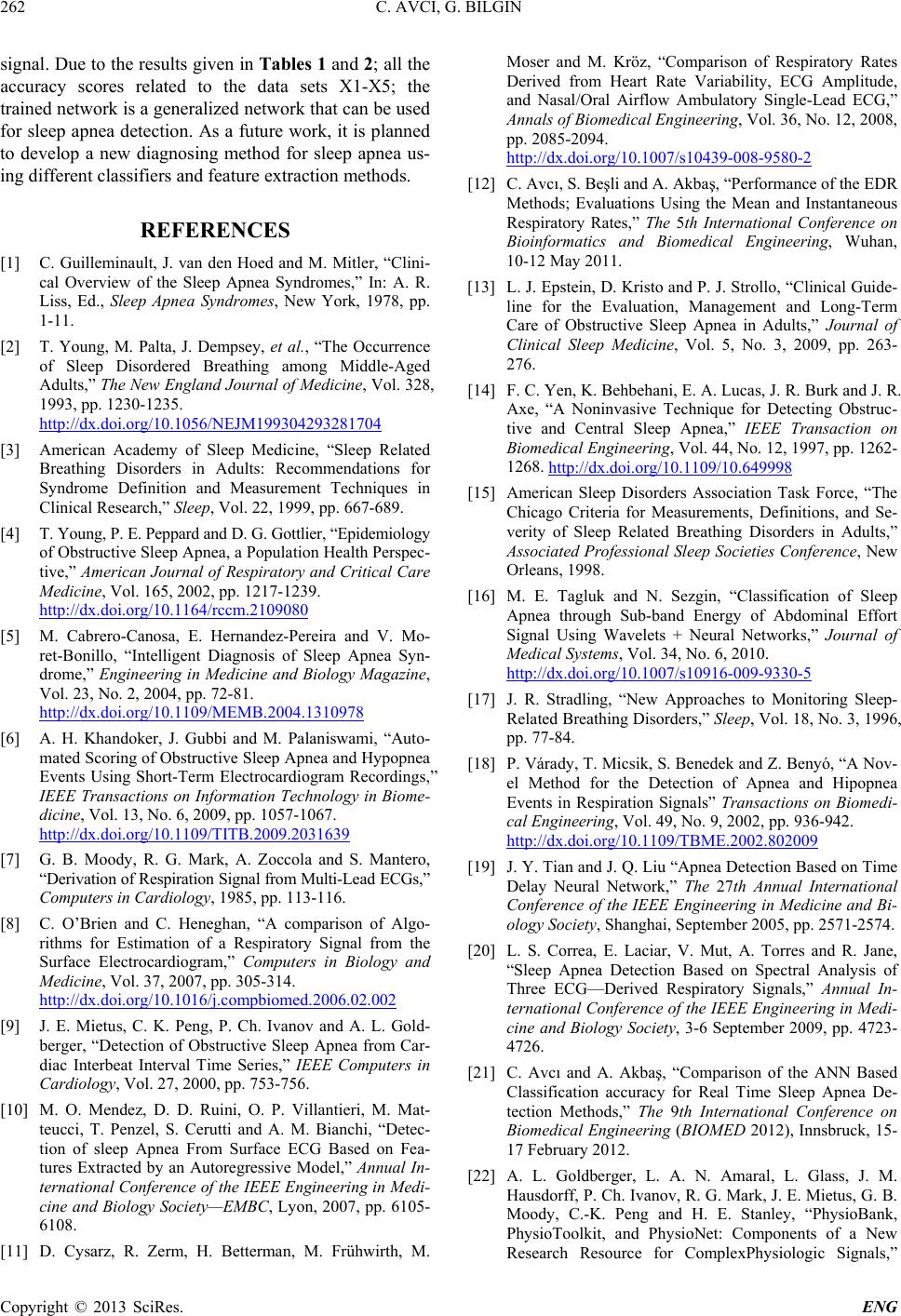
C. AVCI, G. BILGIN
Copyright © 2013 SciRes. ENG
signal. Due to the results given in Tables 1 and 2; all the
accuracy scores related to the data sets X1-X5; the
trained ne twork is a generalized network that can be used
for sleep apnea detection. As a future work, it is planned
to develop a new diagnosing method for sleep apnea us-
ing different classifiers and feature extraction methods.
REFERENCES
[1] C. Guilleminault, J. van den Hoed and M. Mitler, “Clini-
cal Overview of the Sleep Apnea Syndromes,” In: A. R.
Liss, Ed., Sleep Apnea Syndromes, New York, 1978, pp.
1-11.
[2] T. Young, M. Palta, J. Dempsey, et al., “The Occurrence
of Sleep Disordered Breathing among Middle-Aged
Adults,” The New England Journal of Medicine, Vol. 328,
1993, pp. 1230-1235.
http://dx.doi.org/10.1056/NEJM199304293281704
[3] American Academy of Sleep Medicine, “Sleep Related
Breathing Disorders in Adults: Recommendations for
Syndrome Definition and Measurement Techniques in
Clinical Research ,” Sleep, Vol. 22, 1999, pp. 667-689.
[4] T. Young, P. E. Peppard and D. G. Gottlier, “Epidemiology
of Obstructive Sleep Apnea, a Population Health Perspec-
tive,” American Journal of Respiratory and Critical Care
Medicine, Vol. 165, 2002, pp. 1217-1239.
http://dx.doi.org/10.1164/rccm.2109080
[5] M. Cabrero-Canosa, E. Hernandez-Pereira and V. Mo-
ret-Bonillo, “Intelligent Diagnosis of Sleep Apnea Syn-
drome,” Engineering in Medicine and Biology Magazine,
Vol. 23, No. 2, 2004, pp. 72-81.
http://dx.doi.org/10.1109/MEMB.2004.1310978
[6] A. H. Khandoker, J. Gubbi and M. Palaniswami, “Auto-
mated Scoring of Obstructive Sleep Apnea and Hypopnea
Events Using Short-Term Electrocardiogram Recordings,”
IEEE Transactions on Information Technology in Biome-
dicine, Vol. 13, No. 6, 2009, pp. 1057-1067.
http://dx.doi.org/10.1109/TITB.2009.2031639
[7] G. B. Moody, R. G. Mark, A. Zoccola and S. Mantero,
“Derivation of Respiration Signa l from Multi-Lead ECGs,”
Computers in Cardiology, 1985, pp. 113-116.
[8] C. O’Brien and C. Heneghan, “A comparison of Algo-
rithms for Estimation of a Respiratory Signal from the
Surface Electrocardiogram,” Computers in Biology and
Medicine, Vol. 37, 2007, pp. 305-314.
http://dx.doi.org/10.1016/j.compbiomed.2006.02.002
[9] J. E. Mietus, C. K. Peng, P. Ch. Ivanov and A. L. Gold-
berger, “Detection of Obstructive Sleep Apnea from Car-
diac Interbeat Interval Time Series,” IEEE Computers in
Cardiology, Vol. 27, 2000, pp. 75 3-756.
[10] M. O. Mendez, D. D. Ruini, O. P. Villantieri, M. Mat-
teucci, T. Penzel, S. Cerutti and A. M. Bianchi, “Detec-
tion of sleep Apnea From Surface ECG Based on Fea-
tures Extracted by an Autoregressive Model,” Annual In-
ternational Conference of the IEEE Engineering in Medi-
cine and Biology Society—EMBC, Lyon, 2007, pp. 6105-
6108.
[11] D. Cysarz, R. Zerm, H. Betterma n, M. Frühwirth, M.
Moser and M. Kröz, “Comparison of Respiratory Rates
Derived from Heart Rate Variability, ECG Amplitude,
and Nasal/Oral Airflow Ambulatory Single-Lead ECG,”
Annals of Biomedical Engineering, Vol. 36, No. 12, 2008,
pp. 2085-2094.
http://dx.doi.org/10.1007/s10439-008-9580-2
[12] C. Avcı, S. Beşli and A. Akbaş, “Performance of the EDR
Methods; Evaluations Using the Mean and Instantaneous
Respiratory Rates,” The 5th International Conference on
Bioinformatics and Biomedical Engineering, Wuhan,
10-12 May 2011.
[13] L. J. Epstein, D. Kristo and P. J. Strollo, “Clinical Guide-
line for the Evaluation, Management and Long-Term
Care of Obstructive Sleep Apnea in Adults,” Journal of
Clinical Sleep Medicine, Vol. 5, No. 3, 2009, pp. 263-
276.
[14] F. C. Yen, K. Behbeha ni, E. A. Lucas, J. R. Burk and J. R.
Axe, “A Noninvasive Technique for Detecting Obstruc-
tive and Central Sleep Apnea,” IEEE Transaction on
Biomedical Engineering, Vol. 44, No. 12, 1997, pp. 1262-
1268. http://dx.doi.org/10.1109/10.649998
[15] American Sleep Disorders Association Task Force, “The
Chicago Criteria for Measurements, Definitions, and Se-
verity of Sleep Related Breathing Disorders in Adults,”
Associated Professional Sleep Societies Conference, New
Orleans, 1998.
[16] M. E. Tagluk and N. Sezgin , “Classification of Sleep
Apnea through Sub-band Energy of Abdominal Effort
Signal Using Wavelets + Neural Networks,” Journal of
Medical Systems, Vol. 34, No. 6, 2010.
http://dx.doi.org/10.1007/s10916-009-9330-5
[17] J. R. Stradling, “New Approaches to Monitoring Sleep-
Related Breathing Disorders,” Sleep, Vol. 18, No. 3, 1996,
pp. 77-84.
[18] P. Várady, T. Micsik, S. Benedek and Z. Benyó, “A Nov-
el Method for the Detection of Apnea and Hipopnea
Events in Respiration Signals” Transactions on Biomedi-
cal Engineering, Vol. 49, No. 9, 2002, pp. 936-942.
http://dx.doi.org/10.1109/TBME.2002.802009
[19] J. Y. Tia n and J. Q. Liu “Apnea Detection Based on Time
Delay Neural Network,” The 27th Annual International
Conference of the IEEE Engineering in Medicine and Bi-
ology Society, Shanghai, September 2005, pp. 2571-2574.
[20] L. S. Correa, E. Laciar, V. Mut, A. Torres and R. Jane,
“Sleep Apnea Detection Based on Spectral Analysis of
Three ECG—Derived Respiratory Signals,” A nnual In-
ternational Conference of the IEEE Engineering in Medi-
cine and Biology Society, 3-6 September 2009, pp. 4723-
4726.
[21] C. Avcı and A. Akbaş, “Comparison of the ANN Based
Classification accuracy for Real Time Sleep Apnea De-
tection Methods,” The 9th International Conference on
Biomedical Engineering (BIOMED 2012), Innsbruck, 15-
17 February 2012.
[22] A. L. Goldberger, L. A. N. Amaral, L. Glass, J. M.
Hausdorff, P. Ch. Ivanov, R. G. Mark, J. E. Mietus, G. B.
Moody, C.-K. Peng and H. E. Stanley, “PhysioBank,
PhysioToolkit, and PhysioNet: Components of a New
Research Resource for ComplexPhysiologic Signals,”